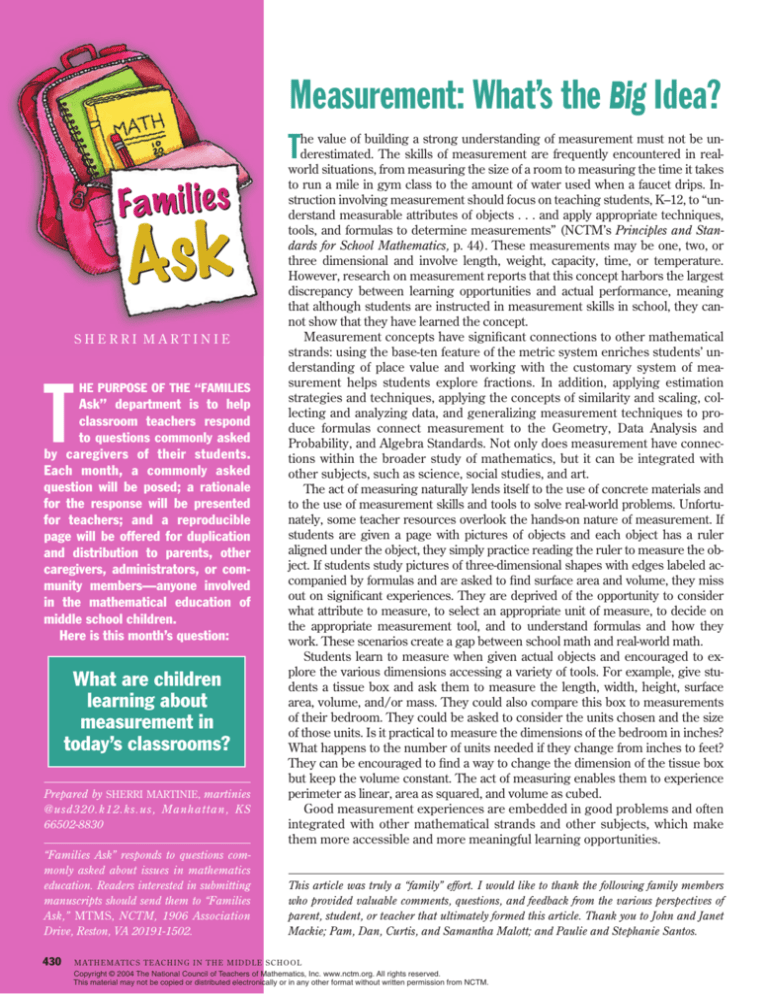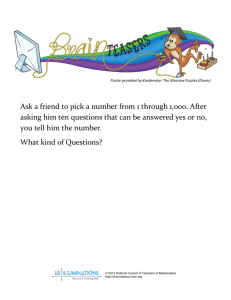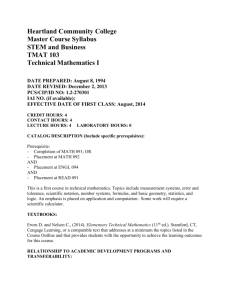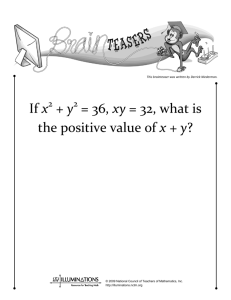
Measurement: What’s the Big Idea?
he value of building a strong understanding of measurement must not be underestimated. The skills of measurement are frequently encountered in realworld situations, from measuring the size of a room to measuring the time it takes
to run a mile in gym class to the amount of water used when a faucet drips. Instruction involving measurement should focus on teaching students, K–12, to “understand measurable attributes of objects . . . and apply appropriate techniques,
tools, and formulas to determine measurements” (NCTM’s Principles and Standards for School Mathematics, p. 44). These measurements may be one, two, or
three dimensional and involve length, weight, capacity, time, or temperature.
However, research on measurement reports that this concept harbors the largest
discrepancy between learning opportunities and actual performance, meaning
that although students are instructed in measurement skills in school, they cannot show that they have learned the concept.
Measurement concepts have significant connections to other mathematical
strands: using the base-ten feature of the metric system enriches students’ understanding of place value and working with the customary system of measurement helps students explore fractions. In addition, applying estimation
strategies and techniques, applying the concepts of similarity and scaling, collecting and analyzing data, and generalizing measurement techniques to produce formulas connect measurement to the Geometry, Data Analysis and
Probability, and Algebra Standards. Not only does measurement have connections within the broader study of mathematics, but it can be integrated with
other subjects, such as science, social studies, and art.
The act of measuring naturally lends itself to the use of concrete materials and
to the use of measurement skills and tools to solve real-world problems. Unfortunately, some teacher resources overlook the hands-on nature of measurement. If
students are given a page with pictures of objects and each object has a ruler
aligned under the object, they simply practice reading the ruler to measure the object. If students study pictures of three-dimensional shapes with edges labeled accompanied by formulas and are asked to find surface area and volume, they miss
out on significant experiences. They are deprived of the opportunity to consider
what attribute to measure, to select an appropriate unit of measure, to decide on
the appropriate measurement tool, and to understand formulas and how they
work. These scenarios create a gap between school math and real-world math.
Students learn to measure when given actual objects and encouraged to explore the various dimensions accessing a variety of tools. For example, give students a tissue box and ask them to measure the length, width, height, surface
area, volume, and/or mass. They could also compare this box to measurements
of their bedroom. They could be asked to consider the units chosen and the size
of those units. Is it practical to measure the dimensions of the bedroom in inches?
What happens to the number of units needed if they change from inches to feet?
They can be encouraged to find a way to change the dimension of the tissue box
but keep the volume constant. The act of measuring enables them to experience
perimeter as linear, area as squared, and volume as cubed.
Good measurement experiences are embedded in good problems and often
integrated with other mathematical strands and other subjects, which make
them more accessible and more meaningful learning opportunities.
T
Families
Ask
SHERRI MARTINIE
T
HE PURPOSE OF THE “FAMILIES
Ask” department is to help
classroom teachers respond
to questions commonly asked
by caregivers of their students.
Each month, a commonly asked
question will be posed; a rationale
for the response will be presented
for teachers; and a reproducible
page will be offered for duplication
and distribution to parents, other
caregivers, administrators, or community members—anyone involved
in the mathematical education of
middle school children.
Here is this month’s question:
What are children
learning about
measurement in
today’s classrooms?
Prepared by SHERRI MARTINIE, martinies
@usd320.k12.ks.us, Manhattan, KS
66502-8830
“Families Ask” responds to questions commonly asked about issues in mathematics
education. Readers interested in submitting
manuscripts should send them to “Families
Ask,” MTMS, NCTM, 1906 Association
Drive, Reston, VA 20191-1502.
430
This article was truly a “family” effort. I would like to thank the following family members
who provided valuable comments, questions, and feedback from the various perspectives of
parent, student, or teacher that ultimately formed this article. Thank you to John and Janet
Mackie; Pam, Dan, Curtis, and Samantha Malott; and Paulie and Stephanie Santos.
MATHEMATICS TEACHING IN THE MIDDLE SCHOOL
Copyright © 2004 The National Council of Teachers of Mathematics, Inc. www.nctm.org. All rights reserved.
This material may not be copied or distributed electronically or in any other format without written permission from NCTM.
Families Take-Home Page
Ask
Families often ask a question like this:
What are children learning about measurement in today’s classrooms?
Measurement skills are frequently used in the real world.
Measurement means many things, from measuring the
size of a room to measuring the time it takes to run a mile
to the amount of water used when a faucet drips. The regular occurrence of measurement opportunities would
make it reasonable to assume that students learn measurement concepts and skills easily, which is not necessarily the case. When looking at how well students learn
measurement, the gap between what students are taught
and what they can actually do is large. You might be wondering why, and what can be done about it.
This gap occurs when the way that students are
taught does not match how they perform with the information. For example, when students are given a page
with pictures of objects and each object has a picture of
a ruler aligned properly under it, students simply practice reading the ruler to measure the object. This scenario is not how measurement is performed in the real
world and results in the inability not only to perform
measurement procedures but also to understand what
the concept of measurement really means.
Realistically, students will need to measure an object
for a specific purpose. They will have to determine for
themselves what needs to be measured. Do they need to
measure the length of the object? Or is it necessary to
find the area, which is what it takes to “cover” a surface?
Maybe the problem they have encountered involves
measuring volume, which is how much it takes to fill a
three-dimensional space. The weight or temperature of
the object may be the feature in question. Regardless,
the student must identify what needs to be measured
and select the appropriate tool. The tool might be a ruler,
tape measure, measuring cup, scale, thermometer, or
some other device. That is why the best way to teach
measurement in school is to find or create situations in
which students need to measure and let them experi-
ence this process. It enables them to see measurement
as a hands-on experience that involves many decisions.
Students learn in school that measurement is connected to many other things. Students learn fractions as
they measure, to a fraction of an inch, objects that are
less than one foot. They see connections to geometry
when they study shapes and consider the measurements of the perimeter and area of those shapes. Not
only do students experience measurement in the study
of other mathematics concepts but also in the study of
other subjects, such as social studies, science, and art.
We can also close the gap in school versus real-life
measurement skills by enabling students to learn measurement formulas in a meaningful way. Students can
learn the formulas for the surface area of a threedimensional shape like a box by carefully “covering”
the surface of the shape with grid paper, then removing the paper to study the area. Using boxes of various
sizes enables students to see a pattern in determining
surface area. They can then generalize this pattern into
a formula to use in the future and to apply to other
three-dimensional shapes, as well.
At home, you can provide your child with opportunities to measure. When you are cooking, ask your child
to get you one-fourth cup of sugar. They will need to decide what tool is needed to measure the ingredients. If
you are grocery shopping, ask your child to get a certain
dollar amount of a fruit or vegetable that is paid for by
the pound. They will need to recognize that a weight
measurement is necessary and will have to find the
scale to measure out the amount needed. Point out labels on bottles and containers; they contain “capacity”
or volume measurement information that tells how
much the bottle or container can hold. You can talk
about objects, their measurable characteristics, and
what tools could be used to measure them.
The best way to teach students about measurement
is to give them opportunities to measure, then discuss
options with them. Measurement is frequently encountered in the real world, so the goal is for students to determine what to measure, decide on an appropriate tool,
select a reasonable unit of measure, and check the reasonableness of their results. From the April 2004 issue of







